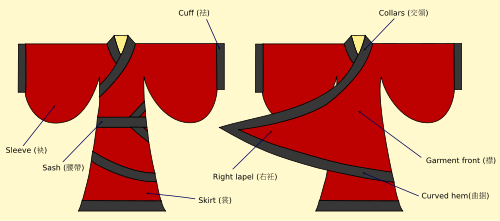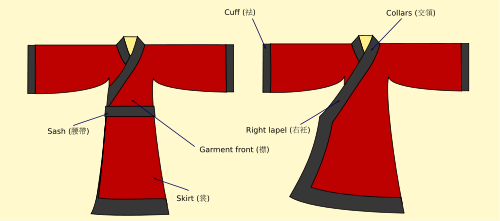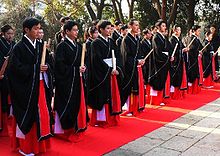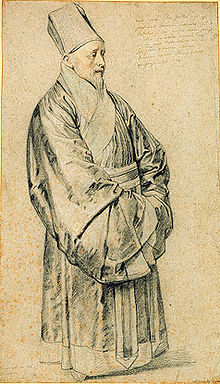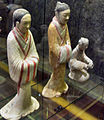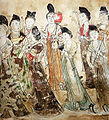- Han Chinese clothing
-
Hanfu 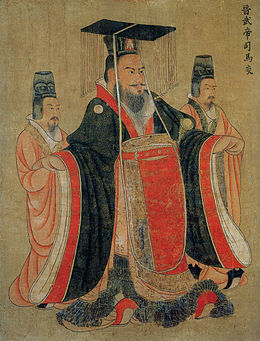
The mianfu of Emperor Wu of Jin Dynasty, 7th century painting by court artist Yan Liben Traditional Chinese 漢服 Simplified Chinese 汉服 Hanyu Pinyin hànfú Literal meaning Han Chinese clothing Transcriptions Mandarin - Hanyu Pinyin hànfú Min - Hokkien POJ hànho̍k Cantonese (Yue) - Jyutping hon3 fuk6 Hanfu (simplified Chinese: 汉服; traditional Chinese: 漢服) or Han Chinese Clothing, also sometimes known as Hanzhuang (漢裝), Huafu (華服), and sometimes referred in English sources simply as Silk Robe[1] (especially those worn by the gentry) or Chinese Silk Robe refers to the historical dress of the Han Chinese people, which was worn for millennia before the conquest by the Manchus and the establishment of the Qing Dynasty in 1644. The term Hanfu derives from the Book of Han, which says, "then many came to the Court to pay homage and were delighted at the clothing style of the Han [Chinese]."[2]
Han Chinese clothing is presently worn only as a part of historical reenactment, festivals, hobby, coming of age/rite of passage ceremonies, ceremonial clothing worn by religious priests, or cultural exercise and can be frequently seen on Chinese television series, films and other forms of media entertainment. However, there is currently a movement in China and overseas Chinese communities to revive Han Chinese clothing in daily life and incorporate it in Chinese festivals or celebrations. Some costumes commonly thought of as typically Chinese, such as the qipao, are the result of influence by laws (Queue Order) imposed by Manchurian rulers of the Qing Dynasty, and are regarded by some advocates as not being "traditionally" Han. Today, most Han Chinese wear Western-style clothing in everyday life. Some urban residents in China wear modified or modernized traditional clothing on some occasions, while many in the countryside still use distinctive peasant dress (though not necessarily identical with classical Hanfu).
Contents
History
Hanfu has a history of more than three millennia, and is said to have been worn by the legendary Yellow Emperor. From the beginning of its history, Hanfu (especially in elite circles) was inseparable from silk, supposedly discovered by the Yellow Emperor’s consort, Leizu. The Shang Dynasty (c.1600 BC-1000 BC), developed the rudiments of Hanfu; it consisted of a yi, a narrow-cuffed, knee-length tunic tied with a sash, and a narrow, ankle-length skirt, called chang, worn with a bixi, a length of fabric that reached the knees. Vivid primary colors and green were used, due to the degree of technology at the time.
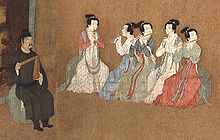 12th century Chinese painting of The Night Revels of Han Xizai (韩熙载夜宴图) showing musicians dressed in Hanfu
12th century Chinese painting of The Night Revels of Han Xizai (韩熙载夜宴图) showing musicians dressed in Hanfu
The dynasty to follow the Shang, the Western Zhou Dynasty, established a strict hierarchical society that used clothing as a status meridian, and inevitably, the height of one’s rank influenced the ornateness of a costume. Such markers included the length of a skirt, the wideness of a sleeve and the degree of ornamentation. In addition to these class-oriented developments, the Hanfu became looser, with the introduction of wide sleeves and jade decorations hung from the sash which served to keep the yi closed. The yi was essentially wrapped over, in a style known as jiaoling youren, or wrapping the right side over before the left, because of the initially greater challenge to the right-handed wearer (the Chinese discouraged left-handedness like many other historical cultures, considering it unnatural, barbarian, uncivilized and unfortunate).
In the Eastern Zhou Dynasty, the "deep robe" (shenyi) appeared a combination of tunic and skirt. The upper and lower halves were cut separately but sewn as a single unit. An additional change was the shaping of the left side of the costume into a corner, fastened on the chest. Perhaps because of Confucian influence, disapproving of a hierarchical society in favour of social mobility based on personal merit, the shenyi was swiftly adopted. There still existed an elite however, and they monopolised the more ornate fabrics and grandiose details.
History of the term "Hanfu"
Since Song and Yuan, official record used Hanfu to indicate garments Hans wear. During Liao dynasty, the emperor of Liao and Han officials wear Hanfu, and Empress and Khitan officials wear their national clothing. During Yuan dynasty, when editing History of Liao, the officials especially made an entry for Hanfu.
The term "Hanfu" to describe the clothing system of Hans, was not often used within Hans, but was more often used in other ethnic groups and nations, to distinguish the Hans clothing system and their own clothing system.
Standard Style
Garments
The style of Han Chinese clothing can be summarized as containing garment elements that are arranged in distinctive and sometimes specific ways. This may be different from the traditional garment of other ethnic groups in China, most notably the Manchu-influenced Chinese clothes, the qipao, which is popularly assumed to be the solely recognizable style of "traditional" Chinese garb. A comparison of the two styles can be seen as the following provides:
Component Han Manchu Upper Garment Consist of "yi" (衣), which have loose lapels and are open Consist of "pao" (袍), which have secured lapels around the neck and no front openings Lower Garment Consist of skirts called "chang" (裳) Consist of pants or trousers called "ku" (褲) Collars Generally, diagonally crossing each other, with the left crossing over the right Parallel vertical collars with parallel diagonal lapels, which overlap Sleeves Long and loose Narrow and tight Buttons Sparingly used and concealed inside the garment Numerous and prominently displayed Fittings Belts and sashes are used to close, secure, and fit the garments around the waist Flat ornate buttoning systems are typically used to secure the collar and fit the garment around the neck and upper torso A complete Hanfu garment is assembled from several pieces of clothing into an attire:
- Yi (衣): Any open cross-collar garment, and worn by both sexes
- Pao (袍): Any closed full-body garment, worn only by men in Hanfu
- Ru (襦): Open cross-collar shirt
- Shan (衫): Open cross-collar shirt or jacket that is worn over the yi
- Qun (裙) or chang (裳): Skirt for women and men
- Ku (褲): Trousers or pants
People are also able to accessorize with tassels and jade pendants or various ornaments hung from the belt or sash, known as pei (珮).
Hats and headwear
On top of the garments, hats (for men) or hairpieces (for women) may be worn. One can often tell the profession or social rank of someone by what they wear on their heads. The typical types of male headwear are called jin (巾) for soft caps, mao (帽) for a stiff hats and guan (冠) for formal headdress. Officials and academics have a separate set of hats for them, typically the putou (幞頭), the wushamao (烏紗帽), the si-fang pingding jin (四方平定巾; or simply, fangjin: 方巾) and the Zhuangzi jin (莊子巾). A typical hairpiece for women is a ji (笄) but there are more elaborate hairpieces.
Style
Han-Chinese clothing had changed and evolved with the fashion of the days since its commonly assumed beginnings in the Shang dynasty. Many of the earlier designs are more gender-neutral and simple in cuttings. Later garments incorporate multiple pieces with men commonly wearing pants and women commonly wearing skirts. Clothing for women usually accentuates the body's natural curves through wrapping of upper garment lapels or binding with sashes at the waist.
Each dynasty has their own styles of Hanfu as they evolved and only few styles are 'fossilized'.
Informal wear
Types include tops (yi) and bottoms (divided further into pants and skirts for both genders, with terminologies chang or qun), and one-piece robes that wrap around the body once or several times (shenyi).
- Shenyi (深衣): a long full body garment
-
- Quju (曲裾): diagonal body wrapping
- Zhiju (直裾): straight lapels
- Zhongyi (中衣) or zhongdan (中單): inner garments, mostly white cotton or silk
- Shanqun (衫裙): a short coat with a long skirt
- Ruqun (襦裙): a top garment with a separate lower garment or skirt
- Kuzhe (褲褶): a short coat with trousers
- Zhiduo/zhishen (直裰/直身): a Ming Dynasty style robe, similar to a zhiju shenyi but with vents at the side and 'stitched sleeves' (i.e. the sleeve cuff is closed save a small opening for the hand to go through)
 Two traditional forms of ruqun (襦裙), a type of Han Chinese clothing worn primarily by women. Cuffs and sleeves on the upper garment may be tighter or looser depending on style. A short skirt or weighted braid (with weight provided by a jade or gold pendant) is sometimes worn to improve aesthetics or comfort of the basic ruqun.
Two traditional forms of ruqun (襦裙), a type of Han Chinese clothing worn primarily by women. Cuffs and sleeves on the upper garment may be tighter or looser depending on style. A short skirt or weighted braid (with weight provided by a jade or gold pendant) is sometimes worn to improve aesthetics or comfort of the basic ruqun.
A typical set of Hanfu can consist of two or three layers. The first layer of clothing is mostly the zhongyi (中衣) which is typically the inner garment much like a Western T-shirt and pants. The next layer is the main layer of clothing which is mostly closed at the front. There can be an optional third layer which is often an overcoat called a zhaoshan which is open at the front. More complicated sets of Hanfu can have many more layers.
For footwear, white socks and black cloth shoes (with white soles) are the norm, but in the past, shoes may have a front face panel attached to the tip of the shoes. Daoists, Buddhists and Confucians may have white stripe chevrons.
Semi-formal wear
A piece of Hanfu can be "made semi-formal" by the addition of the following appropriate items:
- Chang: a pleated skirt
- Bixi (蔽膝): long front cloth panel attached from the waist belt
- Zhaoshan (罩衫): long open fronted coat
- Guan or any formal hats
Generally, this form of wear is suitable for meeting guests or going to meetings and other special cultural days. This form of dress is often worn by the nobility or the upper-class as they are often expensive pieces of clothing, usually made of silks and damasks. The coat sleeves are often deeper than the shenyi to create a more voluminous appearance.
Formal wear
In addition to informal and semi-formal wear, there is a form of dress that is worn only at confucian rituals (like important sacrifices or religious activities) or by special people who are entitled to wear them (such as officials and emperors).
Formal garments may include:
- Xuanduan (玄端): a very formal dark robe; equivalent to the Western white tie
- Daopao/Fusha (道袍/彿裟): Taoist/Buddhist priests' full dress ceremonial robes
- Yuanlingshan (圓領衫), lanshan (襴衫) or panlingpao (盤領袍): closed, round-collared robe; mostly used for official or academical dress
The most formal Hanfu that a civilian can wear is the xuanduan (sometimes called yuanduan 元端[3]), which consists of a black or dark blue top garment that runs to the knees with long sleeve (often with white piping), a bottom red chang, a red bixi (which can have a motif and/or be edged in black), an optional white belt with two white streamers hanging from the side or slightly to the front called peishou (佩綬), and a long black guan. Additionally, wearers may carry a long jade gui (圭) or wooden hu (笏) tablet (used when greeting royalty). This form of dress is mostly used in sacrificial ceremonies such as Ji Tian (祭天) and Ji Zu (祭祖), etc., but is also appropriate for state occasions. The xuanduan is basically a simplified version of full court dress of the officials and the nobility.
Those in the religious orders wear a plain middle layer garment followed by a highly decorated cloak or coat. Taoists have a 'scarlet gown' (絳袍)[4] which is made of a large cloak sewn at the hem to create very long deep sleeves used in very formal rituals. They are often scarlet or crimson in color with wide edging and embroidered with intricate symbols and motifs such as the eight trigrams and the yin and yang Taiji symbol. Buddhist have a cloak with gold lines on a scarlet background creating a brickwork pattern which is wrapped around over the left shoulder and secured at the right side of the body with cords. There may be further decorations, especially for high priests.[5]
Those in academia or officialdom have distinctive gowns (known as shangfu 常服 in court dress terms). This varies over the ages but they are typically round collared gowns closed at the front. The most distinct feature is the headwear which has 'wings' attached. Only those who passed the civil examinations are entitled to wear them, but a variation of it can be worn by ordinary scholars and laymen and even for a groom at a wedding (but with no hat).
Court dress
Court dress is the dress worn at very formal occasions and ceremonies that are in the presence of a monarch (such as an enthronement ceremony). The entire ensemble of clothing can consist of many complex layers and look very elaborate. Court dress is similar to the xuanduan in components but have additional adornments and elaborate headwear. They are often brightly colored with vermillion and blue. There are various versions of court dress that are worn for certain occasions.
Court dress refers to:
Romanization Hanzi Definition Mianfu 冕服 religious court dress of emperor, officials or nobility Bianfu 弁服 ceremonial military dress of emperor, officials or nobility Chaofu 朝服 a red ceremonial court dress of emperor, officials or nobility Gongfu 公服 formal court dress according to ranks Changfu 常服 everyday court dress The practical use of court dress is now obsolete in the modern age since there is no reigning monarch in China anymore.
Specific Style
Historically, Han Clothing has influenced many of its neighbouring cultural costumes, such as Japanese kimono, yukata,[6][7] and the Vietnamese áo tứ thân.[8][9] Elements of Hanfu have also been influenced by neighbouring cultural costumes, especially by the nomadic peoples to the north, and Central Asian cultures to the west by way of the Silk Road.[10][11]
Tang Dynasty Hanfu
Tang Dynasty was a period of golden age for the people where culture and economy were thriving. Especially, the Women's dress and personal adornments saw some major reform in this era. Although it still continues the clothing of its predecessors such as Han and Sui dynasties, fashion during the Tang was also influenced by its cosmopolitan culture and arts. Communications and trades were flourishing between the Tang and many places and cultures and that it has changed the thoughts and concepts of the old practices. Before the Tang, Chinese women were restricted by the old Confucian code where a woman's status was low and her clothing had to be concealed. However during the Tang, women's clothing gradually became broad and loose. Tang Dynasty was considered by some as another turning point for Hanfu.[12] During the Tang era, foreign culture was lively accepted by the Chinese and blended into Chinese traditional culture. Such foreign cultures ranged from Gandhara, Turkistan, Persian to Hellenism, while these influences were fused together into the Tang clothing without the prominence of one particular culture.[13]
Song Dynasty Hanfu
Some features of Tang Clothing carried into the Song Dynasty Such as court customs. Song court customs often use red color for their garments with black leather shoe and hats.Collar edges and sleeve edges of all clothes that have been excavated were decorated with laces or embroidered patterns. Such clothes were decorated with patterns of peony, camellia, plum blossom, and lily, etc. Song Empress often had three to five distinctive Jewelry-like marks on their face (Two side of the cheek,other two next to the eyebrows and one on the forehead). Although some of Song clothing have similarities with previous dynasties, some unique characteristics separate it from the rest. Many of Song Clothing goes into Yuan and Ming.[14]
Ming Dynasty Hanfu
Ming Dynasty also brought many changes to its clothing as many dynasties do. They implemented metal buttons and the collar changed from the symmetrical type of the Song Dynasty (960-1279) to the main circular type. Compared with the costume of the Tang Dynasty (618-907), the proportion of the upper outer garment to lower skirt in the Ming Dynasty was significantly inverted. Since the upper outer garment was shorter and the lower garment was longer, the jacket gradually became longer to shorten the length of the exposed skirt. Young ladies in the mid Ming Dynasty usually preferred to dress in these waistcoats. The waistcoats in the Qing Dynasty were transformed from those of the Yuan Dynasty. During the Ming Dynasty, Confucian codes and ideals was popularized and it has significant effect on clothing.[15]
Types of Han Chinese clothing Han clothing Headwear Other Ethnic identity
According to Tang Dynasty scholar Kong Yingda's official commentary to Zuo Zhuan and Shang Shu, Chinese clothing plays an important role in the Chinese ethnic identity. It says, "In China, there is the grandeur of rites and social conduct; that is why it is called Xia (夏). There is the beauty of dress and decoration; this is called Hua (華).[16]" The words Hua and Xia combine to form the word Huaxia (華夏), which is a name that is often used to represent the Chinese civilization.[17][18]
Gallery
-
A Han Dynasty (202 BCE – 220 CE) pottery statuette of a female dancer
-
Court ladies of the Tang from Li Xianhui's tomb, Qianling Mausoleum, dated 706.
-
A painting of Tang Dynasty women playing with a dog, by artist Zhou Fang, 8th century.
-
A Song Dynasty empress, wife of Emperor Zhenzong of Song
-
The imperial shangfu robe of Tianqi Emperor of Ming Dynasty
-
A Ming Dynasty portrait of an Empress
-
A Ming Dynasty portrait of a noblewoman wearing yuanlingshan, xiapei and phoenix crown
-
Matteo Ricci and Xu Guangqi dressed in Ming Dynasty Hanfu.
-
Taoist priest in red colored gown
See also
- Hanfu movement
- List of Han Chinese clothing
- Culture of China
- Chinese academic dress
- Guan Li
- Mandarin square
Notes
- ^ Gernet, Jacques (1962). Daily Life in China on the Eve of the Mongol Invasion, 1250-1276. Translated by H. M. Wright. Stanford: Stanford University Press. p. 130. ISBN 0-8047-0720-0.
- ^ 《漢書》云:『後數來朝賀,樂漢衣服制度。』
- ^ Xu, Zhongguo Gudai Lisu Cidian, p. 7.
- ^ Daoist Headdresses and Dress - Scarlet Robe
- ^ High Priest of the Shaolin Monastery
- ^ Stevens, Rebecca (1996). The kimono inspiration: art and art-to-wear in America. Pomegranate. pp. 131–142. ISBN 0876545983.
- ^ Dalby, Liza (2001). Kimono: Fashioning Culture. Washington, USA: University of Washington Press. pp. 25–32. ISBN 0-295-98155-5.
- ^ 《大南實錄・正編・第一紀・世祖實錄》,越南阮朝,國史館
- ^ 《大南实录・正编・第一纪・卷五十四・嘉隆十五年七月条》,越南阮朝,國史館
- ^ Finnane, Antonia (2008), Changing clothes in China: fashion, history, nation, Columbia University Press, pp. 44–46, ISBN 0231143508, http://books.google.com/books?id=Ju3N4VeiQ28C&q=nomad#v=snippet&q=nomad
- ^ Kim, Sohyun. A Study on the Costume of Khotan, The Korean Society of Costume, v. 34, 169-183. 1997.
- ^ Costume in the Tang Dynasty chinaculture.org retrieved 2010-01-07
- ^ Yoon, Ji-Won (2006). Research of the Foreign Dancing Costumes: From Han to Sui-Tang Dynasty. 56. The Korean Society of Costume. pp. 57–72. http://ocean.kisti.re.kr/IS_mvpopo212L.do?cn1=JAKO200617033616779&poid=kna&method=download.
- ^ Costume in the Song Dynasty chinaculture.org retrieved 2010-01-07
- ^ Costume in the Ming Dynasty chinaculture.org retrieved 2010-01-07
- ^ 孔穎達 《春秋左傳正義‧定公‧卷五十六‧傳十年》注疏云:『中國有禮儀之大,故稱夏;有服章之美,謂之華。』
- ^ 孔穎達 《尚書正義》注疏云:『冕服華章曰華,大國曰夏。華夏,謂中國也。』
- ^ 《唐律名例疏義釋義》有言:『中華者,中國也,親被正教,自屬中國,衣冠威儀,習俗孝悌,居身禮義,故謂之中華。』
References
- Zhou Xibao (1984), 【中國古代服飾史】 Zhongguo Gudai Fushi Shi (History of Ancient Chinese Costume), Beijing: Zhongguo Xiju.
- Zhou, Xun; Gao, Chunming; The Chinese Costumes Research Group (1984), 5000 Years of Chinese Costume, Hong Kong: The Commercial Press. ISBN 962-07-5021-7
- 許嘉璐 Xu Jialu (1991), 【中國古代禮俗辭典】 Zhongguo Gudai Lisu Cidian (Dictionary of Rituals and Customs of Ancient China).
- 沈從文 Shen Congwen (1999, 2006), 【中國古代服飾研究】 Zhongguo Gudai Fushi Yanjiu (Researches on Ancient Chinese Costumes), Shanghai: Shanghai Century Publishing Group. ISBN 7-80678-329-6
- 黃能馥, 陳娟娟 Huang Nengfu and Chen Juanjuan (1999), 【中華歷代服飾藝術】 Zhonghua Lidai Fushi Yishu (The Art of Chinese Clothing Through the Ages), Beijing.
- 華梅 Hua, Mei (2004), 【古代服飾】 Gudai Fushi (Ancient Costume), Beijing: Wenmu Chubanshe. ISBN 7-5010-1472-8
External links
Categories:- Chinese clothing
- Han Chinese
- History of Asian clothing
Wikimedia Foundation. 2010.


